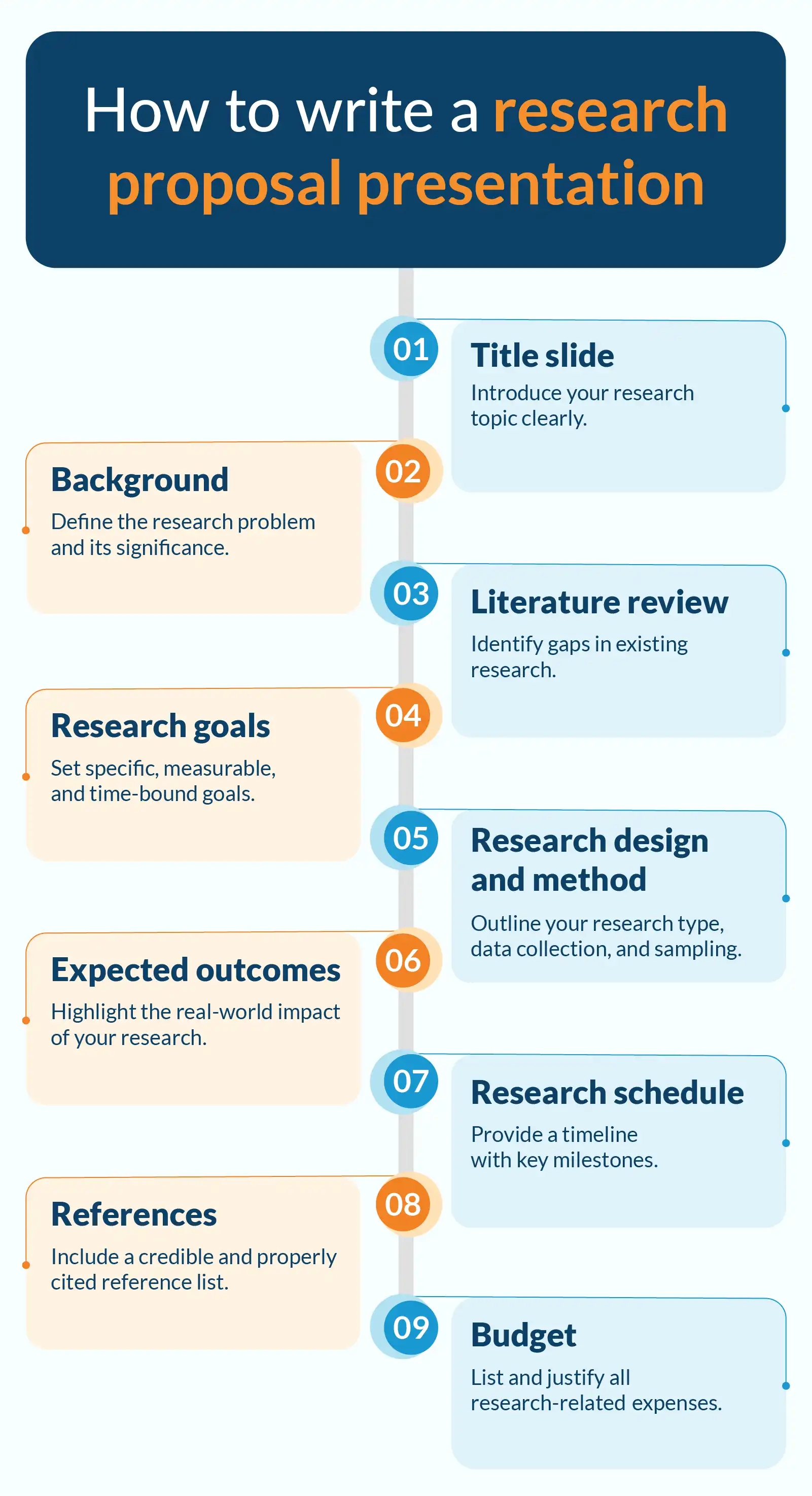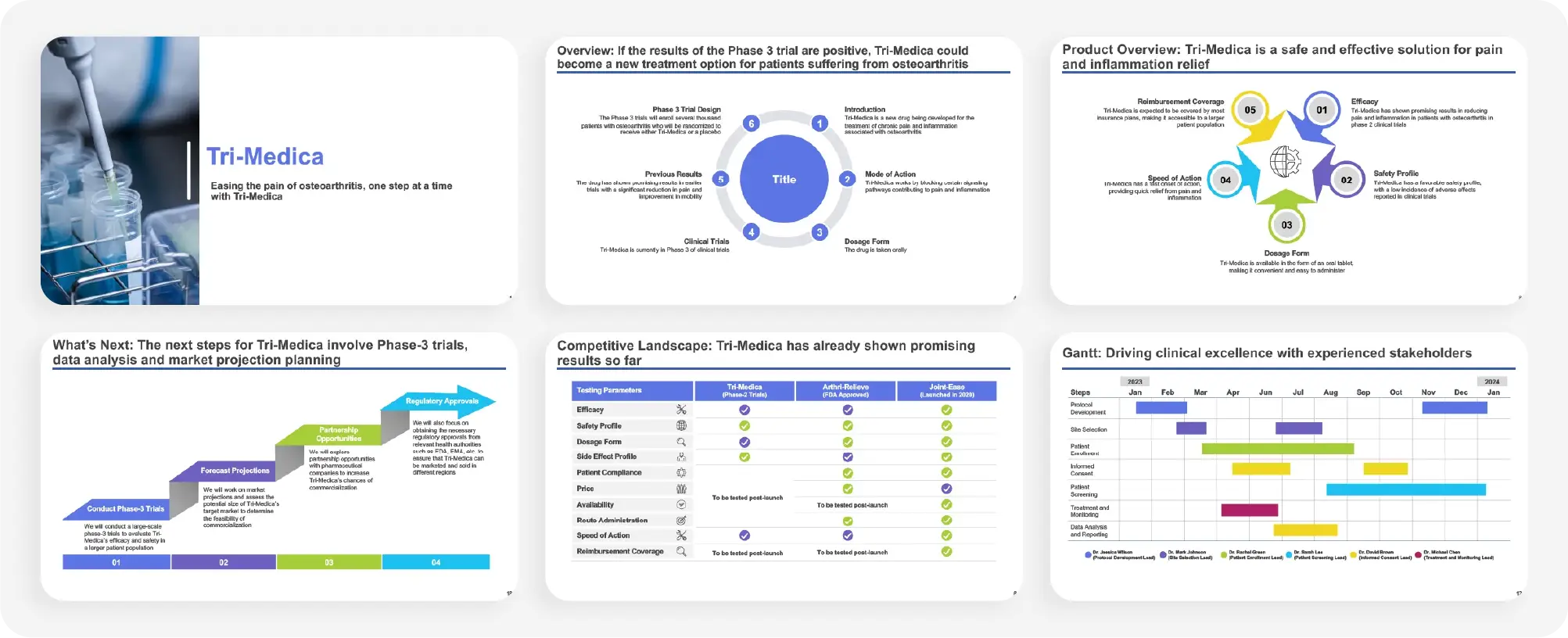How to write a research proposal | Guide with examples and template

Research proposals play a very important role in companies as they assist in informed decision-making, securing funding, and justifying the allocation of resources to projects. A well-crafted proposal can be a huge contributing factor to success, whether it is a research initiative aiming to understand market trends or a study to improve product performance. Companies that depend on quality research often require these documents to outline project objectives, timelines, budgets, and methodologies, making the proposals an integral part of corporate strategy.
Your proposal can clearly present the action plan to help the business make the right decision and ensure that it invests in a feasible project with tangible outcomes.
What is a research proposal?
A research proposal is a detailed plan outlining the key aspects of a research project. The main purpose of the proposal is to convince stakeholders of the validity and feasibility of the proposed study. It provides a roadmap for conducting the research, including the methods and goals.
In essence, a good research proposal should explain:
- What is the research problem and its importance?
- How will the research be conducted?
- What are the expected outcomes?
- What are the resources required for the research?
Essential elements of an effective research proposal PPT:
The success of a proposal depends largely on how well it is presented and communicated to the relevant stakeholders. Therefore, the proposal has to be structured effectively to engage the audience while conveying critical information. An impactful proposal presentation must include several essential elements:
1. Required personalization:
You should tailor your proposal to the specific needs of the audience. Understanding the concerns and objectives of stakeholders is essential to ensure that your proposal resonates with your intended audience.
For example, a presentation aimed at senior executives might focus on financial implications, while a pitch to a technical team must explore the research methodology in detail.
2. Compelling narrative:
An effective research proposal tells a story. This means that when you present your proposal, you are narrating a problem, your research approach, and the potential impact in an engaging way while ensuring that the urgency of the research is highlighted.
3. Effective data visualization:
Using data visualization techniques like charts, graphs, and other visual techniques can significantly enhance one's understanding of complex technical information. Data visualization allows the audience to grasp complex data quickly, making the presentation more engaging and accessible.
For example:
- Use bar charts to compare projected costs vs. expected benefits.
- Include pie charts to illustrate market share based on existing research.
4. Consistency:
Consistency in design, tone, and language helps to build credibility. Using a uniform style for fonts, headings, and colors is advisable throughout the proposal presentation. Ensuring consistency not only makes the proposal visually appealing but also professional.
Consistency also applies to content as well. This means that your research goals should align with company objectives.
5. Audience engagement:
Your proposal presentation should not be a monologue, but it should encourage audience interaction as well. A few engagement strategies that you can include in your session are:
- Asking questions throughout the presentation.
- Inviting feedback on the proposed methods or objectives.
- Offering a clear call to action (e.g., approval of the research budget).
How to write a research proposal presentation?
Writing the proposal involves several key sections that together form a comprehensive plan for your research. There are a number of factors in a research which will defer from industry to industry, but the objective of the proposal will remain constant. Your proposal has to act as a guide, providing clarity on the plan, structure, and next steps for your research.
Below is the basic structure your proposal must have.
1. Introduce with relevant title:
The title slide serves as the introduction or the initial pitch of the research idea. It should clearly reflect the specific topic of the research and briefly capture the essence of the study, giving the audience a clear idea of what to expect in the upcoming slides.
2. Enhance understanding with proper background:
The background section provides context for your research. This section is essential as it explores the previous study in the same context and explores the loopholes that need to be addressed. Therefore, this section covers the following:
- Present the research problem: Clearly define the issue or gap your research intends to address.
- Highlight the significance: Explain why your research is important and what its potential impact is on the field.
- Review of available research: Summarize relevant studies to show how your research fits into the broader academic conversation.
3. Conducting a thorough literature review:
A literature review is essential for understanding the existing knowledge related to your research topic. It involves identifying relevant studies, summarizing key findings, and highlighting gaps in the current research. This demonstrates that you have conducted due diligence and positions your study as a meaningful contribution to the existing body of knowledge.
4. Define the goal of a research proposal:
Clearly define the research goal to establish a solid foundation for your presentation. This will ensure your audience understands your study's aims. Clearly stating your research goals and objectives provides a clear focus and direction. This helps you prepare for any questions the audience may have about your topic.
When outlining your research goals, they should be:
- Specific: Clearly define the focus of your study to avoid any ambiguity.
- Measurable: Ensure your goals allow for the assessment of progress and outcomes.
- Achievable: Ensure to establish realistic goals that can be accomplished within the scope of your research.
- Relevant: Align your objectives with the broader context of the research problem.
- Time-bound: Set a clear timeframe for achieving your research objectives.
5. Research design and methods:
Research design and methods provide the framework for how you will conduct your research, outlining the specific methodology you plan to use. This includes:
- Research type: Clarify whether your study will use qualitative, quantitative, or mixed methods in the research question.
- Data collection methods: Explain how you will collect your data, whether through primary sources like surveys and interviews or secondary sources such as existing research and archives.
- Research methods: Outline the specific methodology, including any tools or techniques, and justify why this approach is suitable for your study.
- Sample details: Describe the sample population, how it will be selected, and the rationale behind its size and composition.
6. Expected research outcomes:
Explain how the results could be applied in real-world contexts, addressing practical problems or influencing industry practices. This section will emphasize the value of your research and demonstrate how it can drive real-world change.
7. Creating a research schedule:
Timelines are crucial in research as they provide a clear roadmap of the project's progression and help ensure effective time management. This section should provide details on:
- Key milestones: Identify major phases of the research project, such as literature review, data collection, and analysis.
- Set deadlines: Establish deadlines for each phase to ensure timely completion.
For example, creating a Gantt chart or a similar visual tool can help in tracking progress and staying organized.
8. Including a reference list:
Include a comprehensive citation list at the end of your proposal. In your presentation, be sure to:
- Cite sources accurately: Use a standard citation style like APA to credit original authors and avoid plagiarism properly. If you're unsure how to do this effectively, exploring some practical tips to avoid plagiarism can help you stay on the right track and maintain academic integrity.
- Assess source credibility: Check the relevance and reliability of each source to ensure it aligns with your research topic.
9. Budget:
A detailed budget is essential for understanding the financial requirements of your research project. Including a well-structured budget helps to clarify the ask and assists in securing research funding and managing resources effectively. Your budget slide should:
- Itemize costs: List all expected expenses, such as equipment, materials, and personnel.
- Justify expenses: Provide explanations for each budget item to demonstrate its necessity.

Common mistakes to avoid in research proposal presentations:
Research is often too extensive, and the need to present effectively makes the presenters lose focus on the essentials.
When presenting a proposal, it is essential to avoid a few common mistakes that can affect its effectiveness. Here are some key mistakes that are commonly noticed:
- Lack of clarity: Ensure clarity in your proposal and organize it. Avoid jargon and overly complex language that can confuse readers.
- Inadequate literature review: A superficial review of existing research can make your proposal look weak. Therefore, provide a thorough analysis of relevant studies to establish a solid foundation for your research.
- Unclear objectives: Clearly define your research objectives and questions. Over ambitious goals can make it difficult for reviewers to understand the purpose of your study.
- Poor research design: A flawed or incomplete research design can impact the validity of your study. Ensure that your methodology is well thought out and appropriate for your research objectives.
- Missing budget details: A lack of detailed budget information can raise concerns about the feasibility of your research. Provide a detailed budget to support your proposal.
- Neglecting the proposal structure: Your proposal should follow a clear and logical structure. Unorganized content can distract the audience and affect its overall quality.
Research proposal example: Template
Below is a research proposal template for clinical trial investment created by Prezent. This presentation provides a clear, structured format that covers all the key elements needed to secure funding for clinical trial research. The features of this template include:
- Clear logical structure: The presentation is organized in a way that helps the audience understand all the factors contributing to the research and achieving its goals.
- Compelling narrative: The PPT follows a clear storyline, making it easier for the audience to understand the information and remember key points.
- Effective data visualization: High-quality visuals not only enhance the professionalism of the presentation but also provide the audience with clear insights without overwhelming them with too much information.

FAQs:
Q1. How long should a research proposal presentation be?
A. The length of a research proposal presentation depends on the audience and setting but should typically be concise—around 10 to 20 minutes. This ensures that you cover the core components of your research plan or dissertation proposal without losing audience interest. A shorter presentation allows time for questions, which is key for audience engagement and showcasing the depth of your proposed research.
Q2. How do I prepare for audience questions related to the research?
A. In order to prepare for audience questions, anticipate inquiries that might arise based on your research proposal structure. Be thoroughly familiar with your research design, data collection methods, and how your study addresses the research problem. Review previous research and existing literature in your field to provide informed responses. Practice answering questions with colleagues or mentors, focusing on your research objectives and the implications of your research. This preparation will help you confidently respond to both expected and unexpected queries during the presentation.
Q3. How can I present data-heavy slides for better clarity and easy understanding?
A. Data-heavy slides can be effectively presented by simplifying the visuals and organizing information logically. Use charts, graphs, and infographics to represent data collection methods and key findings, ensuring each visual highlights a clear insight. Avoid overloading the slides with text—focus on the important research outcomes. Use consistent colors, labels, and fonts to improve readability. Breaking down large datasets into manageable sections and explaining their relevance helps the audience better understand and retain the information. This approach aligns with academic writing principles by providing clarity without overwhelming the audience.
Q4. What tools can help in creating research proposal presentations?
A. There are several tools available to help create effective research proposal presentations. Prezent offers structured templates tailored for research proposals, ensuring a logical flow and strong visualization of data. Other tools like PowerPoint, Canva, and Prezi can also assist in designing professional presentations. These platforms provide templates that help you organize your research study and highlight the key points of your proposed research, saving time and improving the overall impact of your presentation.
How does Prezent assist in creating effective research proposal presentations?
Research presentations can be challenging because they involve a lot of technical data and information. Organizing and structuring this information takes time and effort to ensure it is clear and impactful for the audience.
Prezent AI is designed to address the major challenges associated with complex research presentations.
- Simplification of technical data: Prezent breaks down intricate information into an easy-to-understand format using compelling narratives and effective data visualization.
- Saving time in presentation creation: The platform features over 1,000 storylines and more than 35,000 slides, enabling you to create impactful presentations in 80% less time than before.
- Personalization for the audience: This smart AI platform allows you to easily tailor your research presentation by analyzing audience preferences and choices. The hyper-personalization feature not only helps you present what your audience seeks but also assists in avoiding common mistakes that can diminish the impact of your proposal.
Prezent offers many more features to help you enhance presentation quality and improve team efficiency. Discover the full potential of Prezent by scheduling a demo with our experts. Alternatively, you can explore the platform on your own by using your free trial.



.avif)








